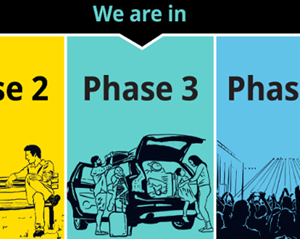
Thursday July 16, 2020 ~ VICTORIA, BC [Updated 3:50 pm]
Editorial Analysis by Mary Brooke, B.Sc., Editor ~ West Shore Voice News
BC has pretty much the lowest COVID-19 infection rates and death counts in Canada, if not the western world. Which means that Provincial Health Officer Dr Bonnie Henry’s approach to “our pandemic in BC” has worked in terms of keeping people safe as the first wave of COVID-19 has arrived and spread in the province.
Today’s messaging in a brief presentation by phone to media today by Provincial Health Officer Dr Bonnie Henry and Dr Danuta Skowronski was that British Columbians deserve the credit for flattening the curve.
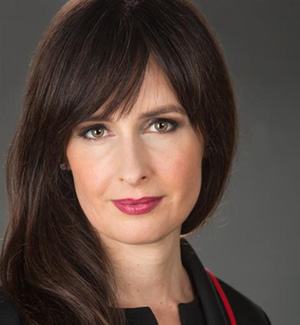
Dr Skowronski is the lead researcher of a team of scientists who on July 15 released a paper about their study of blood samples in BC during March and May, as published on the MedRxiv.org website (a PrePrint Server to Health Sciences).
The joint study between B.C. Centre for Disease Control, University of British Columbia (UBC), LifeLabs and public health scientists was released Wednesday and shows B.C.’s estimated overall infection rate is less than one percent.
The two-part conclusion that the PHO’s approach worked to keep people home — and that people did stay home — is based on finding a very low level of exposure to COVID-19 infection (i.e. antibodies) in blood samples taken during the first phase of the pandemic.
Results showed that there was very little community spread. It primarily means people stayed home as they were asked to, avoiding interaction in the community and the economy. That’s part one. The impacts of shutdown are part two.
Very little natural immunity:
BC’s success with flattening the curve also means there is next to zero natural (herd/community) immunity among British Columbians as the virus continues to circulate in the community, and that continued extreme caution (physical distancing, small bubbles, no exposure in crowds or in prolonged close contact, etc) needs to be adhered to by everyone.
That’s not to say that natural immunity is a realistic expectation or even resilient when found. Dr Henry says that at least 60% of the population would need to be immune in order to achieve community immunity. Earlier this week Canada’s Deputy Chief Public Health Officer Dr Howard Njoo said that so far it appears that natural immunity lasts a few weeks to a few months at best.
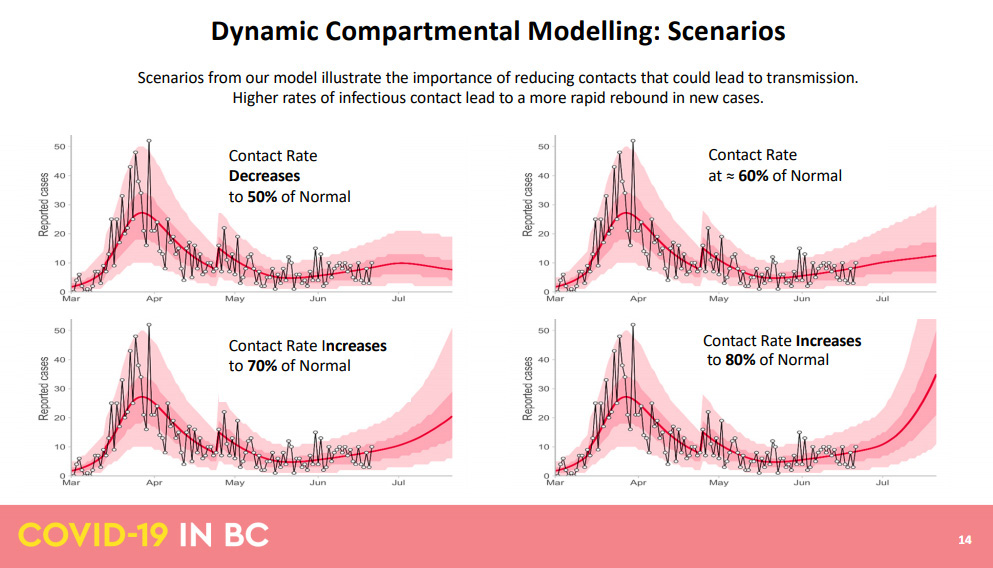
At some point the urge for social interaction will erode people’s cooperation with physical distancing and staying away from full social and economic contact. But hopefully not until a vaccine or effective treatment is available. The desired pull-back on activity (compared to pre-COVID) is about 65%, based on data modelling presented by Dr Henry on June 23, 2020.
Meanwhile, the so-called ‘unintended consequences’ of lockdown and phased restart are mounting, including damage to people’s economic well-being, social interactions and mental health.
“We cannot rest on our laurels. We cannot assume that we are in the all-clear,” Skowronski said.
A gamble with “our pandemic”:
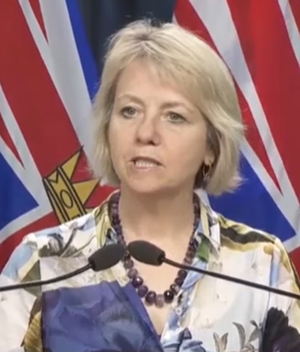
Overall this means that BC’s direction from the Public Health Officer to produce “our pandemic in BC” has been a gamble — albeit a well-qualified one. The risk-taking has been around guessing at the cooperation and compliance of British Columbians being able to outrun the virus until a vaccine or treatment is available against COVID-19.
There is a myriad of moving parts. Not the least of which include:
- the behaviour of individuals and their continued desire to be resilient to social, financial and emotional impacts;
- the cohesion of communities and their ability to cope financially and to provide services;
- the speed and skill with which scientists and public health can develop, produce and deliver a vaccine;
- the continued availability of all manner of resources for testing, PPE and hospitalization support; and
- the continued stability of governments (presently federal Liberal counter-balanced in COVID support by NDP in opposition; and NDP people-first in BC) to make resources available and open all doors to allow for success.
This is a complex multi-dimensional chess board upon which British Columbians are the pawns, government is king, public health is the queen, medical science and financial resource for that are the rooks, municipalities and communities are the bishops, and the virulence of COVID-19 is the game board itself which could tip and topple in unpredictable ways. And bigger than the BC COVID game board itself is the raging storm of the pandemic as a global phenomenon which could tip or smash the board and send all the players flying.
Emergency preparedness reigns supreme:

As a side note, there has never been a more important time to continue being ’emergency prepared’. This COVID experience is not over yet. Until there is an effective treatment or a vaccine all individuals, families, households, communities, schools, businesses and governments are at the mercy of an unprecedented range of external impacts (and the internal impacts in response).
As the COVID-19 virus remains in the community and a second wave is likely given the numerous factors that could burst our BC bubble (not the least of which would be opening up travel more and in particular the Canada/ US border if and when that happens), having enough groceries, PPE, financial resources and other survival-related plans in place is just common sense.
Eye on the big picture:
Reliance on the food supply chain and the availability of financial resources being made available to the science and pharmaceutical manufacturing sector are probably the two most important big-picture perspectives for individuals and governments alike to pay attention to.
Chinks already seen in the food supply chain across the country include the need for cross-border transport of goods (opening up the risk of COVID spread), infection infiltration by which of temporary foreign workers, a lack of labour available for farming operations to harvest their crops, and a loss of export customers (for the financial stability of farmers) or their ability to ship products to market due to transportation limitations and/or border restrictions.
In BC there has been good work to isolate and support temporary foreign workers who tested positive for COVID-19.
As for resources to public health, science and the manufacturing sector — governments have been forthcoming until now but deep pockets may possibly dry up.
About the BC CDC / UBC study:
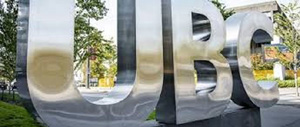
The study to detect aspects of immunity to COVID-19 in blood samples as available through COVID testing and other non-COVID-related blood samples (available through LifeLabs) created snapshots of the level of antibodies present in the population at various intervals to gauge changes in population rates, changes, and residual susceptibility in the population.
The study explored anonymous blood samples as collected in March and May for reasons unrelated to COVID-19. In the March (early in the pandemic) samples the virus was prevalent in 0.28% of the samples. In the May samples (after a few months of potential exposure), it was present in 0.55%. So there is evidence of some spread during the March to May period, but at low levels compared to most other locations in Europe and the USA.
The sampling methodology aimed to avoid bias by not seeking volunteers, as it was felt that would have produced samples from people already having reason to believe they had the COVID-19 infection.
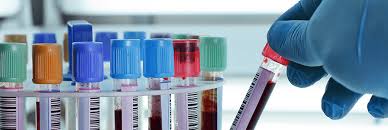
Testing was done on a collection of 1,000 blood samples from people living in the BC Lower Mainland area where Skowronski says her team “expected infection rates to be highest”. But she said it was “lower than what we estimated for that area”.
The sample represented all age groups — about 100 samples for each 10-year age band. “By age and sex it was a good representation”. They partnered with the private sector LifeLabs as they are “the only out patient community-based lab network serving the lower mainland and thereby offering a representative snapshot of community residents”, said Skowronski .
Under direction of the provincial health officer the data was anonymized. They also used blood samples left over from other diagnostic testing (from individuals who may have been presenting for other screening). “This removes the element of invitation or donation or volunteerism and that removes a potential for error in the estimates,” said Skowronski.
However, that approach did also possibly miss a lot of people who probably did have exposure to COVID-19 (who might have come forward for testing if asked). The study was therefore about proving the efficacy of the economic shutdown (including self-isolation and retreat from community contact) rather than aggressively pursuing a range of antibody responses in the collective blood pool.
BC survey results coming next week:

Almost 400,000 people in BC voluntarily participated in an online survey in May as presented by the BC Centre for Disease Control under the direction of Dr Henry.
Survey participants were offered the opportunity to be part of serology studies. Findings from the survey (and any blood studies that have happens as a result) will be presented on Monday July 20, said Dr Henry today.
COVID-19 data modelling in BC:
Modelling and projections by the BC Centre for Disease Control are posted online. To date, there have been five modelling presentations, delivered on March 27, April 17, May 4, June 4, and June 23.
![Hon John Horgan, MLA [Langford-Juan de Fuca]](https://islandsocialtrends.ca/wp-content/uploads/2020/04/LFDJdFConstituency-WSVN-covid-banner-728x90-web.jpg)



